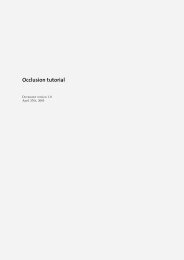mental ray Architectural and Design Visualization Shader Library
mental ray Architectural and Design Visualization Shader Library
mental ray Architectural and Design Visualization Shader Library
You also want an ePaper? Increase the reach of your titles
YUMPU automatically turns print PDFs into web optimized ePapers that Google loves.
2.3 Features 9The rules are as follows:• Transparency takes energy from Diffuse, i.e.diffuse at all.at 100% transparency, there will be no• Reflectivity takes energy from both Diffuse <strong>and</strong> Transparency, i.e. at 100% reflectivitythere will neither be any diffuse nor any transparency.• Translucency is a type of transparency, <strong>and</strong> refr trans w defines the percentage oftransparency vs. translucency.From left to right: Reflectivity 0.0, 0.4, 0.8 <strong>and</strong> 1.0From left to right: Transparencies 0.0, 0.4, 0.8 <strong>and</strong> 1.0It also means that the level of highlights is linked to the glossiness of a surface. A highrefl gloss value causes a narrower but very intense highlight, <strong>and</strong> a lower value causes awider but less intense highlight. This is because the energy is now spread out <strong>and</strong> dissipatedover a larger solid angle.2.3.3 BRDF - how Reflectivity Depends on AngleIn the real world, the reflectivity of a surface is often view angle dependent. A fancy termfor this is BRDF (Bi-directional Reflectance Distribution Function), i.e. a way to define howmuch a material reflects when seen from various angles.
















